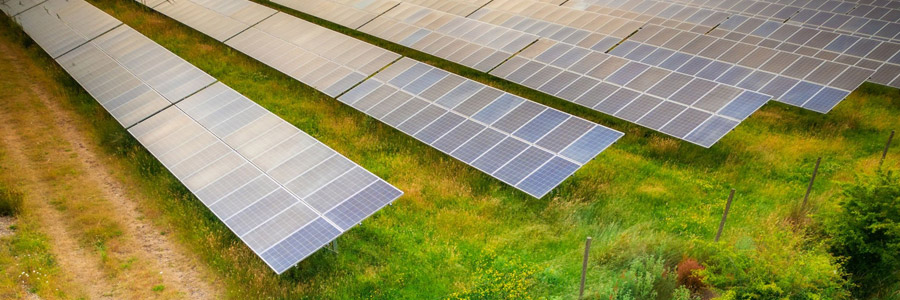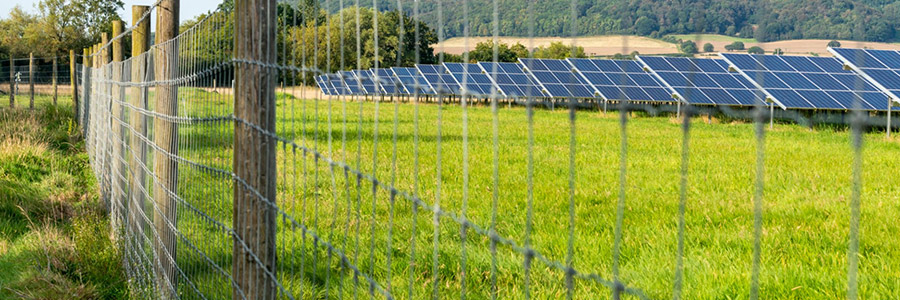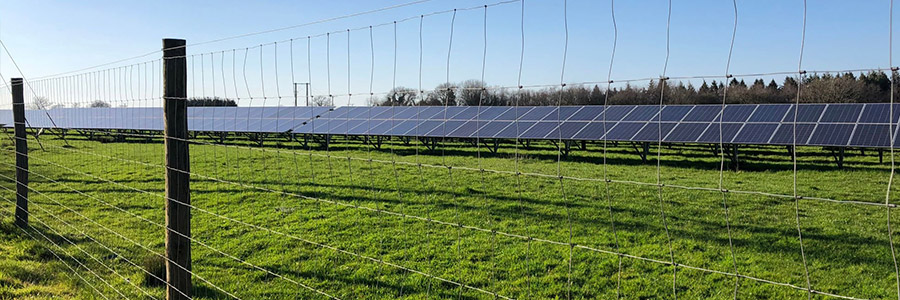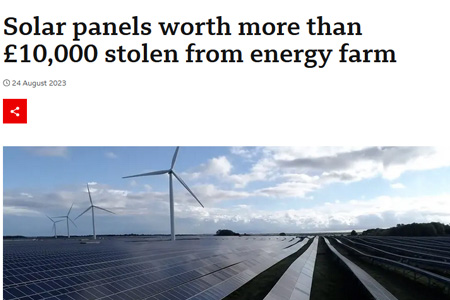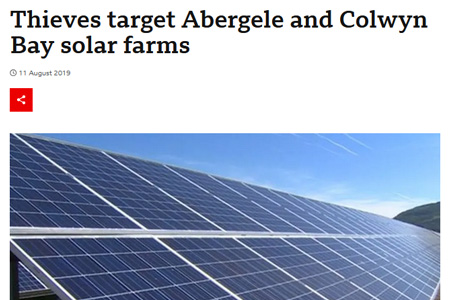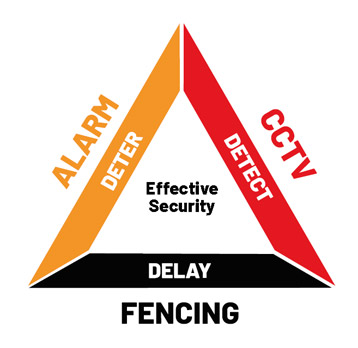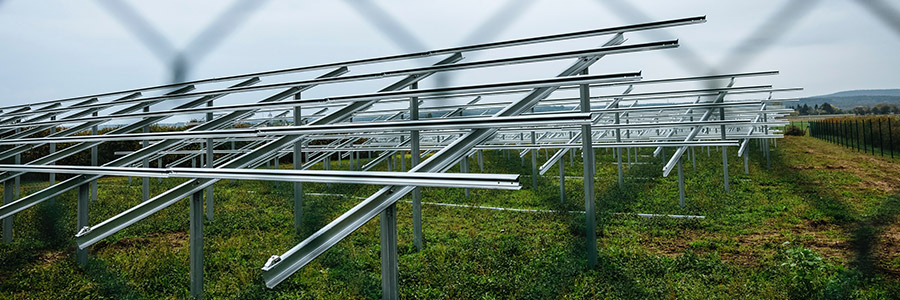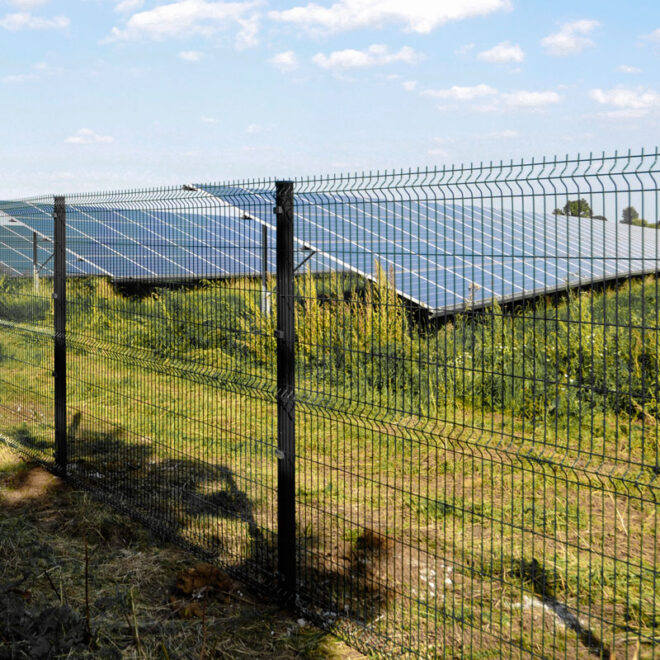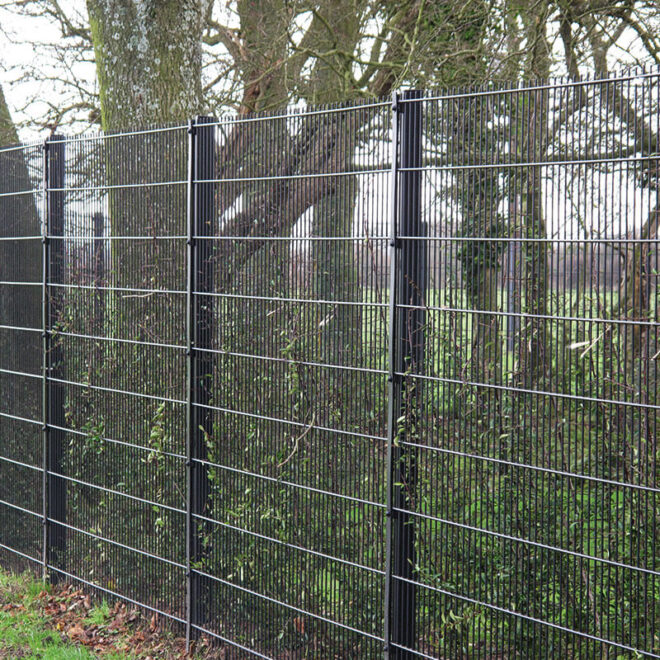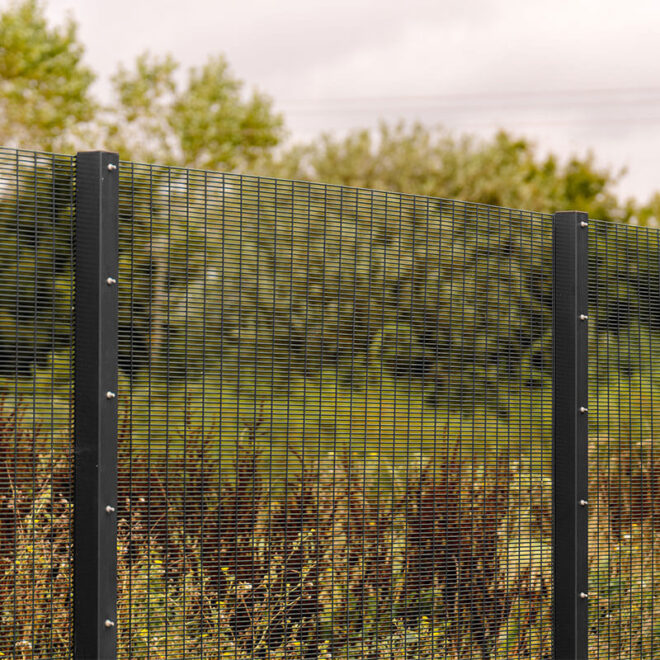Published:
Perimeter Security for Renewable Energy Sites
Renewable energy sites are becoming a familiar sight across rural landscapes, reflecting the shift towards greener energy sources.
Historically, rural landowners have relied on deer fencing to protect crops and forests from wildlife, but as renewable energy infrastructure expands, the need for more advanced security measures has become apparent.
We explore why deer fencing, once effective for rural protection, is no longer suitable for securing these modern, high-value sites. We will examine the limitations of deer fencing, the increasing security requirements for renewable energy facilities, and the importance of adopting a comprehensive security approach, in line with police recommendations.
The Limitations of Deer Fencing for Renewable Energy Sites
The UK’s commitment to renewable energy has led to a surge in wind farms, solar farms, and other renewable energy projects, often situated in remote or rural areas.
These locations are chosen for their wide-open spaces and suitable environmental conditions, but they present unique security challenges.
Unlike traditional rural operations, renewable energy sites house expensive, high-tech equipment that requires protection from a range of risks, including theft, vandalism, and trespassing. As these sites proliferate, it becomes clear that traditional fencing solutions are no longer up to the task.
While deer fencing has proven effective in preventing wildlife intrusions, it falls short when tasked with protecting renewable energy infrastructure.
- Lack of deterrence for human intrusion
- Inability to withstand tampering or forced entry
- No integration with modern surveillance and access control systems
Incidents of theft, vandalism, and unauthorised access are on the rise at these valuable sites, exposing the inadequacies of deer fencing in a modern context.
Theft From Solar Farms with Deer Fencing
Solar farm theft is a growing concern, with data showing a significant increase in reported incidents over the past few years. Criminal gangs will also repeat target sites in the same area once they identify weak perimeter security. This trend highlights the need for enhanced security measures as solar farms become increasingly targeted by organised crime.
Factors Driving Theft From Solar Farms
- Crime from solar farms is partially driven by the cost of copper – currently £6k per ton.
- Solar farms are considered an easier target than traditional targets such as sub-stations, water works and building sites.
- Not only is it costly to replace stolen cables, there is no public funding available for replacement parts.
- In addition, the loss of revenue from energy generation while the site is being repair can be considerable.
- European solar thefts typically cause £50,000 of damage, when repairs and loss of business are factored in.
Police Guidelines Regarding Deer Fencing
Police strategic planning teams and crime prevention officers are increasingly advising that deer fencing is not suitable for solar farm perimeter use.
- “Deer/stock boundary fencing in relation to crime is not sufficient to deter or mitigate a crime risk and provides only a symbolic boundary.” – Essex Police
- “Deer fencing should not be considered a substitute for security fencing for protecting vulnerable parts of the site”. – Essex Police
- “Open site lines should be combined with stronger boundary treatments where possible” – Essex Police
- “Deer fencing and hedging for security will provide an inadequate deterrent” – Derbyshire Police
- “Stock proof boundary fencing would provide little deterrence value at all” – Northumbria Police
- “Security Fencing rather than post and rail is the minimum requirement for a Solar Farm” – Northumbria Police
- “If perimeter fencing is to be used, then it should be a proven security fence” – Devon & Cornwall Police
- “Our recommendation is to install fencing which has been tested to meet a security rating. Non-specialist security fencing is likely to offer at best only a token resistance to intruders” – Devon & Cornwall Police
Police comments on cable theft relating to Solar Farms:
- “The price of copper is set to remain consistent until the second half of 2023, when it is forecast to increase in to 2024. This will drive up the rate of cable theft across all industries, including solar.” – Northumbria Police
- “Research suggests thefts from solar farms are rising exponentially are fuelled by the rising metal prices.” – Essex Police
- “Crime on solar farms has increased by 93% from 2021 to 2022, with a 48% increase in the theft of cables, and theft of solar panels quadrupling in the same time period.” – Northumbria Police
- “A more robust approach to security is needed given the industrial scale of thefts from solar farms nationally.” – Derbyshire Police
The Enhanced Security Needs for Modern Renewable Energy Sites
The high-value equipment on Renewable energy sites and their often-isolated locations make them attractive targets for criminals, activists, or even curious individuals, posing both safety and operational risks. Effective security systems are no longer optional but essential, and fencing must be part of a broader solution that includes technology-driven deterrents. The unique vulnerabilities of these sites demand a move beyond traditional methods of protection.
Modern security concerns for Solar Farms:
- Theft of solar panels, copper wire and cabling.
- Vandalism.
- Protestor activity or sabotage.
- Public liability and health & safety risks from unauthorized entry
Providing An Effective Deterrent – The Perimeter Security Triangle
To meet the demands of modern renewable energy sites, security solutions must go far beyond the simplicity of deer fencing. Today’s best practices involve high-tensile security fencing, often with anti-climb features, and can be integrated with advanced surveillance technology, such as motion detectors and monitored CCTV systems.
These solutions provide a layered approach that addresses both wildlife and human threats.
Limitations of Deer Fencing For Security
The primary function of security fencing is to create a time delay for intruders attempting to breach a site. However, traditional deer fencing offers minimal resistance:
- Easily cut with basic tools
- Wooden posts can be manually uprooted
- Provides no resistance to vehicles
- Large sections of connected fencing can be dismantled from a single access point
The insufficient resistance offered by deer fencing undermines the effectiveness of other security systems, such as CCTV and alarms. Intruders can easily choose their entry point, minimising their exposure to areas monitored by these systems and reducing the overall effectiveness of site security.
In contrast, metal security fencing offers far greater protection and serves as a strong visual deterrent:

Built-in anti-climb features

Significantly more resistant to cutting with basic tools

Requires cutting through entire bays to create a large access point
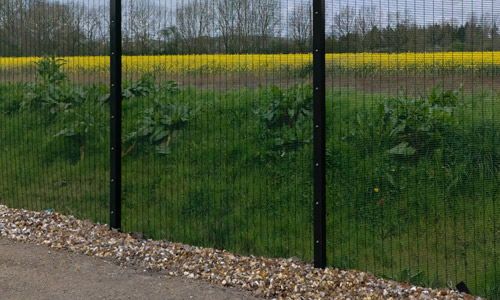
Mesh can be buried into the ground to increase resistance

Much easier to integrate CCTV, meters and alarm systems securely

Tested and certified to provide specific delay times
Another advantage that mesh fencing has over deer fencing is that it is available in different types of mesh panels and can be customised to suit budget, colour, and the level of security required. Below are the three main types of mesh fencing suitable for solar farms:

SolarGard Orbit
Boundary Demarcation Fencing System
We recommend this type of weld-mesh fencing as a demarcation fence, where security is not critical. The single-wire mesh with v-folds provides a system that is more durable than deer fencing, and can easily be stepped for uneven ground.

SolarGard Orbit
Security Rated Boundary Fencing System
We recommend this type of weld-mesh fencing is used where a security rating is important, but ensuring good sight lines is still important. The overlapping wires, stainless steel fixings and full-length clamp bars ensure a higher level of security over v-mesh.
Wildlife Gates
Maintaining the natural movement of wildlife, such as badgers or foxes, across solar farm perimeters is essential for environmental sustainability. Badgers establish well-defined pathways over time, and when these paths are blocked by fencing, it can lead to harmful outcomes, such as trapping, injury, or attempts to breach the fence.
- Specialised wildlife access gates can be installed where these paths intersect with fence lines.
- These gates allow small mammals like badgers to pass through while preventing larger animals from entering.
- Wildlife access gates seamlessly integrate with mesh fencing systems, including a custom gap and powder-coating for aesthetic consistency.
- Gates can be configured to open in one direction or both, ensuring flexible wildlife access without compromising security.
Effective Solar Farm Perimeter Security
Securing your solar farm with a robust fencing system is essential for protecting your investment and ensuring the site’s long-term operation. While deer fencing may initially appear to be a more cost-effective solution, it does not provide the same level of protection against theft or intrusions. Opting for a security-rated fencing system may involve a higher upfront cost, but it will significantly reduce the risk of break-ins, damage, and costly downtime. When considering the financial impact of theft, lost revenue, and increased insurance premiums, investing in a high-quality security fence proves to be a far more economical and reliable choice in the long run.
At Alexandra, we understand the challenges contractors face every day (many years ago, we were contractors ourselves), and we’re committed to supporting you every step of the way by making your job easier and eliminating uncertainty.
We can recommend a complete system for solar farm security installers and have a network of approved installers across the UK who can provide site surveys in their local areas. We offer on-time delivery direct to site, or if you’re in the South East, you can collect directly from us.
Contact our team today for a competitive quote on any of our mesh security systems.



